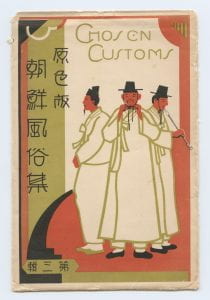Speaker: Stephanie Lee (Ph.D. Candidate, Northwestern University)
“The Social Lives of Picture Postcards“
Discussant: Kaeun Park (Ph.D. Student, University of Michigan)
Wednesday, November 10th, 2021 (Rescheduled to January 12, 2022)
4:45 – 6:45 pm CT, Remotely via Zoom
*Please use this link to register for the zoom meeting.
Abstract:
This paper reads a select group of colonial Korean picture postcards in the East Asia Image Collection at Lafayette University. These postcards, or e-hagaki 絵葉書 flourished from the late nineteenth to early twentieth century. With the standardization of domestic and international postal services and reprographic technologies, ehagaki and its artists illuminated curated snapshots of culture, craft, colonial women, and landscapes for ravenous collectors and tourists. Commissioned by both public bodies like the Government General of Chosŏn and Japanese Government Railways, as well as private entities, like artist-owned sōsaku hanga 創作版画 publishers, postcards allowed Japanese modernist aesthetics, local color, and intimate configurations of labor to be shared with a wide circle of international consumers. In this presentation, I will explore how the picture postcard’s materiality mediates time and knowledge formation at the turn of the century and contemporaneous intimate practices which would change the meanings of the picture postcards.

Envelope for a set of picture postcards. Chosen Customs. Set 3. c.1918-1933. East Asian Image Library, Lafayette University.
********************************
Stephanie Lee studies early modern and modern printmaking, specializing in Dutch and Japanese works-on-paper. Her work is particularly concerned with the role of prints and printmaking in the processes of transcultural mediation within the Japanese Empire. She is currently a Legal Fellow at the Center for Legal Studies and a doctoral student in the Department of Art History at Northwestern University.
Kaeun Park looks at histories of modern and contemporary art and visual culture, with a focus on photography in Korea. She received her Master’s degree in Art History from Binghamton University, and her thesis was titled “Reconsidering Everyday Life Photography: Saenghwalchuŭi Sajin in South Korea in the 1950s and the 1960s”. Her thesis analyzes the discourse of “everyday life photography” and the photographic practice it sustained in South Korea during the 1950s and 1960s. She examines the cultural, artistic, and political conditions under which the conception of “everyday life photography” emerged and was promoted, analyzing the ways in which “everyday life” photographs related to Koreans’ experience of “everyday life (saenghwal)” and also opened a space for social critique.
In her Ph.D. dissertation, she hopes to continue her research on photography from cross-disciplinary and multiregional perspectives. Her dissertation examines postwar South Korean documentary photographic practices. Besides working on photography, she has written on a wide range of topics related to Korean art such as architecture and commercial design during the colonial period, 1970s performance art, and ecological art practices in the late 1980s, among other things.


